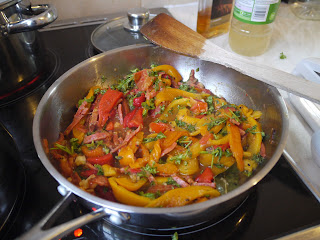Ahh, the Korean seafood pancake! From the first time I had it in our local Korean restaurant, I was hooked. The simplest form is makde with flour, water, a little egg and shredded spring onions. It's so easy that I've even made it on a yacht at 45 degrees heel - admittedly, the cooker was on gimbals. My only difficulty is making it thin enough; over the years I have added more and more batter until it has come out quite thick and glutinous. Recently I went back to Little Seoul and ordered it again, and realised that while it is a thicker pancake than a crepe, it is still thin enough to cook through when crisped up on both sides. Therefore I suggest using a pancake pan rather than a frying pan, and only add enough extra ingredients as your batter can take. The recipe below serves four people as a side dish or starter.
Ingredients:
For the pancake:
Combine the dipping sauce ingredients, whisking gently so the oil is mixed through. Leave to the side while you prepare the pancakes so that the flavours can mellow together.
Break the egg into a bowl and whisk until the yolk and white are combined. Add in half the flour and a quarter of the water and whisk until smooth. Add the rest of the flour and water and combine into a fairly smooth batter, but don't over-beat or the gluten will become tough. Clean, top and tail, slice along the length of the spring onions, and roughly shred, separating the layers. Stir into the batter.
Heat a few tbsp of vegetable oil in a pancake pan until shimmering. Pour in the batter and spread out to the edges with a spatula. Add the shrimp and push them into the batter with the spatula. Cook for about five minutes on a moderate heat, until the bottom is golden brown. Either flip carefully with a large slice-spatula, or slide onto a plate and quickly overturn back into the pan. Cook for a further 3-4 minutes until the other side is done. Rest for a minute or two before slicing into strips or triangles and serve with the dipping sauce.
Ingredients:
For the pancake:
- 1 egg
- 1 cup plain all-purpose flour
- 1 cup cold water
- 5 medium spring onions
- 1/2 cup of cooked brown shrimp or other small seafood, drained of any excess water
- 1/4 cup of medium soy sauce (or diluted down dark soy sauce)
- 1/2 clove garlic, finely minced
- 1/2 spring onion, finely minced
- 1 tbsp rice wine vinegar
- 1 tbsp toasted sesame oil
- 1/2 tsp chilli flakes (optional)
Combine the dipping sauce ingredients, whisking gently so the oil is mixed through. Leave to the side while you prepare the pancakes so that the flavours can mellow together.
Break the egg into a bowl and whisk until the yolk and white are combined. Add in half the flour and a quarter of the water and whisk until smooth. Add the rest of the flour and water and combine into a fairly smooth batter, but don't over-beat or the gluten will become tough. Clean, top and tail, slice along the length of the spring onions, and roughly shred, separating the layers. Stir into the batter.
Heat a few tbsp of vegetable oil in a pancake pan until shimmering. Pour in the batter and spread out to the edges with a spatula. Add the shrimp and push them into the batter with the spatula. Cook for about five minutes on a moderate heat, until the bottom is golden brown. Either flip carefully with a large slice-spatula, or slide onto a plate and quickly overturn back into the pan. Cook for a further 3-4 minutes until the other side is done. Rest for a minute or two before slicing into strips or triangles and serve with the dipping sauce.





















